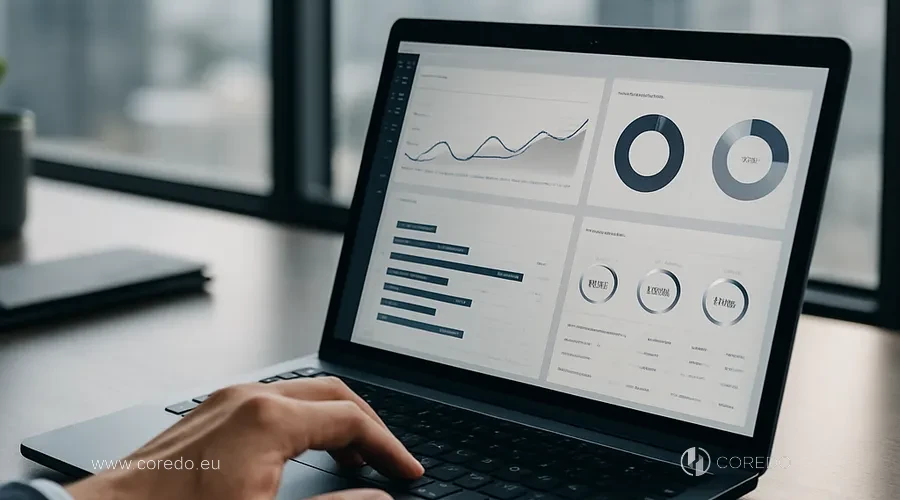85% of companies that have implemented the flywheel model report sustained revenue growth and reduced operating costs already in the first year of transformation, analysts at McKinsey and Forrester concluded in 2024. However, fewer than 20% of international legal and financial firms in the EU and Asia are able to implement the flywheel business model in a way that truly delivers stable financial results and long-term financial resilience for the company. Why? The problem lies not only in the complexity of legal entity registration processes, obtaining financial licenses, or complying with AML requirements, but also in the inability to build the flywheel around clear business goals and eliminate friction points at every stage of the customer journey.
What if I told you that it is the flywheel model — not the classic sales funnel — that can become the driver of continuous growth, business scalability, and increased ROI in international legal consulting?
In this article I will examine in detail how business goals and the correct configuration of the flywheel mechanism form stable financial results. I will share practical recommendations, examples from the experience of COREDO and strategies that will enable entrepreneurs, managers, and finance directors not just to implement a flywheel, but to make it a source of long-term profitability and sustained success. If you want not just to follow trends but to get ahead of them – read the article to the end.
Flywheel model — what is it and how does it work?

The flywheel model is a business model based on the principle of cyclicality and energy accumulation: each action of the company amplifies the next, creating a self-sustaining growth effect (self-sustaining business model).
Unlike the linear sales funnel, where a customer moves from acquisition to purchase and falls out of the cycle, a flywheel business is built around continuous interaction with the customer, where retention and referrals become the key drivers of growth.
Flywheel mechanisms include removing friction points (friction points), automating support processes, integrating CRM and ERP systems, and continuously working with customer insights (customer insights). Even small efforts — for example, automating KYC procedures or implementing digital payment platforms — can trigger a chain reaction: Legal entity registration accelerates, churn rate decreases, customer retention rate increases, and therefore financial result stability improves.
International companies, such as Amazon, Google and Atlassian, have built their flywheel models on principles of continuous growth and constant optimization of the customer experience. For example, Amazon invests in reducing delivery times and automating logistics, which lowers CAC and increases the share of repeat orders, directly affecting ROI and Net Operating Profit After Tax (NOAT). Similarly, COREDO’s practice confirms: implementing a flywheel in legal support and AML services not only speeds up company registration processes in the EU and Asia, but also ensures long-term return on invested capital (ROIC) by reducing costs and improving operational efficiency.
The impact of the flywheel on financial reporting is reflected in growth of key KPIs: customer retention rate, reduction of CAC, increase in average revenue per user (ARPU), and reduction of churn rate. This not only improves the transparency and predictability of revenues, but also allows building the company’s growth strategy based on real data rather than hypotheses.
Business goals and the role of the flywheel model

Any flywheel business begins with properly formulated goals. In COREDO’s international practice we see that setting SMART goals (Specific, Measurable, Achievable, Relevant, Time-bound) is the foundation for launching a flywheel model. Goals should be not only financial (for example, revenue growth of 15% per year or reducing CAC by 20%), but also operational: reducing company registration time in the EU to 5 business days, achieving an AML compliance rate above 98%, and reducing the number of friction points in the customer journey.
The link between business goals and financial stability and long-term investment profitability is obvious: only clearly defined goals make it possible to manage working capital, optimize costs, and build a flywheel that does not lose momentum even under conditions of high competition or changes in regulatory requirements.
Aligning team goals and adopting agile methodologies plays an important role. At COREDO we implemented a system of regular strategic sessions where the team evaluates progress on KPIs (customer retention rate, churn rate, ARPU, NOAT) and quickly adapts processes to new market challenges. This approach not only minimizes risks but also maintains high employee motivation, which is critical for a flywheel business.
To assess the effectiveness of a flywheel model, the key metrics become:
- Customer retention rate — the share of customers who continue cooperation year after year.
- Customer acquisition cost (CAC) — the cost of acquiring a new customer.
- Churn rate — the percentage of customers leaving the company over a given period.
- Flywheel model ROI: return on investments made in automation, process optimization and customer experience development.
Regular monitoring of these KPIs allows not only identifying friction points, but also timely implementing changes, supporting stable financial results and sustainable company growth.
Thus, building a sustainable flywheel requires not only clear goals and flexible processes, but also a thoughtful approach to operational support, which becomes especially significant in the legal field and when complying with AML requirements.
Flywheel mechanisms in legal support and AML

In international legal practice, the flywheel model stands out especially clearly when it comes to company registration, obtaining financial licenses and AML consulting. The specifics of the field, the high regulatory burden, the need for strict adherence to compliance procedures and constant risk management.
The solution developed at COREDO to support company registration in the EU, Asia and Africa is built on automating key stages: from collecting and verifying documents to integration with government registries and banks. This approach not only speeds up the registration process, but also minimizes errors related to the human factor, which is critical for complying with AML and KYC requirements.
Flywheel and AML services are not just about automating client checks, but about building a unified digital loop where each new registration or Licensing enhances the company’s reputation, reduces risks and increases trust from regulators and partners. The implementation of digital payment platforms and fintech solutions allows COREDO to ensure transaction transparency, automatic monitoring of suspicious activity and instant incident response.
Integration of CRM and ERP systems, process automation of support and digital transformation of the business allow not only to increase operational efficiency, but also to create a scalable flywheel model capable of maintaining stable financial results even with a sharp increase in client volume or changes in regulatory requirements across different jurisdictions.
Thus, the implemented flywheel model becomes the foundation of sustainable development, and further analysis will show how it affects customer retention and contributes to business growth.
Impact of the flywheel on customer retention and business growth

The flywheel model is not only about growth, but also about customer retention. In legal support and AML services, repeat engagements, referrals and long-term client loyalty become the basis of stable financial results. COREDO’s practice has shown that implementing referral marketing and systematic work with customer insights accelerates the flywheel, reducing CAC and increasing the share of organic acquisition.
Customer data analytics and sales funnel optimization allow identifying and eliminating friction points: for example, automating the company registration application process or obtaining a license reduces waiting time and lowers the likelihood of errors. This directly affects revenue growth and increased customer satisfaction.
Flywheel and revenue growth are closely linked through reduced operating costs and increased ARPU. At COREDO we integrated digital payment platforms and automated compliance tools, which not only sped up service delivery but also elevated the customer experience to a new level.
Scaling a business through the flywheel is especially relevant for international companies operating in the EU, Asia and Africa. Regional specifics, differences in regulatory requirements, language barriers, and levels of digitalization require flexibility and adaptability of the flywheel model. COREDO’s experience shows that only continuous process optimization and adaptation to market specifics preserve competitive advantage and ensure long-term return on investment.
Implementing the flywheel for stable financial results
| Stage of flywheel implementation | Key actions | Metrics to monitor | Risks and ways to minimize them |
|---|---|---|---|
| Setting goals | Defining SMART goals, aligning the team | KPI: customer retention rate, CAC | Insufficient communication, resistance to change |
| Process optimization | Elimination of frictions, automation of CRM/ERP | ROI, NOAT | Technical failures, integration errors |
| Risk management | Implementation of AML and compliance, monitoring | Compliance rate, risk level | Non-compliance with regulatory requirements |
| Monitoring and adaptation | Customer data analytics, agile methodologies | Churn rate, ROIC | Delays in analysis, incorrect conclusions |
Flywheel for businesses in the EU and Asia: best practices
- Automating the flywheel for business growth: integrating digital tools, automating KYC/AML and document workflow, implementing digital payment platforms.
- Eliminating friction points: regular audits of the customer journey, optimizing communications, implementing omnichannel support services.
- Metrics to monitor: customer retention rate, CAC, churn rate, NOAT, ROIC, compliance rate.
- Working capital management: transparent planning and cash flow control, minimizing costs at each stage of the flywheel.
Examples of successful implementation
In one COREDO case for a fintech client in Singapore, a flywheel was implemented where automation of registration and AML support processes reduced the time to launch a new product from 3 months to 3 weeks, and the customer retention rate increased by 22% over a year. In another project for a company entering the EU market, implementing the flywheel and integrating CRM/ERP reduced CAC by 18% and delivered a 27% increase in revenue by improving customer loyalty and optimizing business processes.
These examples illustrate how integrating flywheel mechanisms and digital solutions can directly affect business efficiency and key growth metrics.
Let’s move on to the key takeaways and concrete steps for entrepreneurs.
Key takeaways and steps for entrepreneurs

The flywheel model, it’s not just moNot just a fashionable trend, but a strategic tool for achieving stable financial results, the company’s long-term financial resilience and ROI growth. Key insights:
- Setting business goals – the foundation for launching the flywheel, ensuring team alignment and process transparency.
- Optimization of business processes and the elimination of friction points: the key to accelerating the flywheel and increasing customer loyalty.
- Risk management and AML integration – a necessary condition for successful business scaling in international jurisdictions.
- Digital transformation and automation, drivers of operational efficiency and long-term ROI.
- Continuous monitoring of KPIs and agile methodologies, tools for adapting strategy and maintaining a competitive advantage.
COREDO’s practice shows: only a systemic approach to implementing the flywheel, based on deep customer insights, modern technologies and continuous process improvement, allows you not just to react to market changes but to shape its future. If your goal is stable financial results, revenue growth and the company’s long-term sustainability, the flywheel model becomes not an alternative, but a necessity in modern legal and financial business.